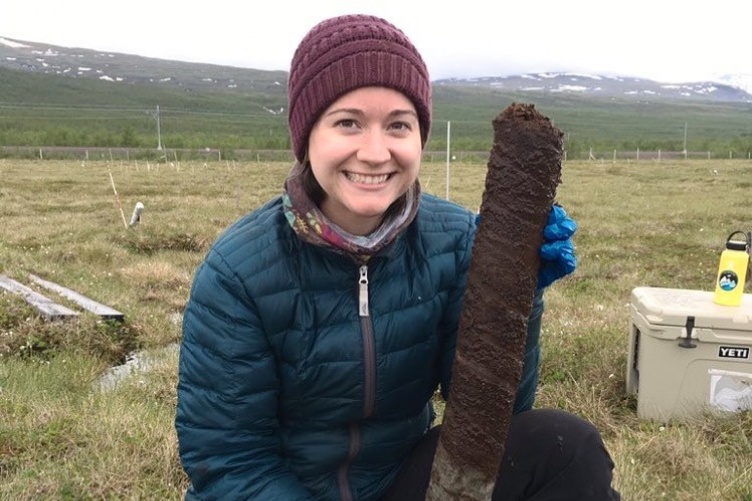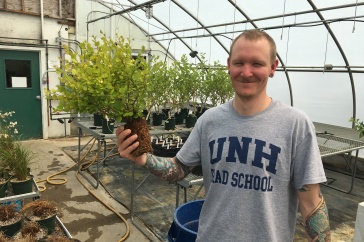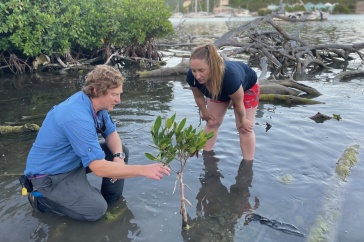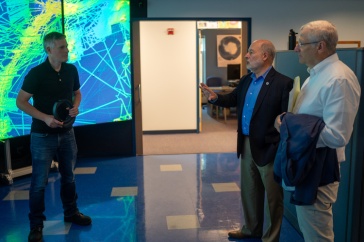
Stacey Doherty and her collaborators are have focused on identifying ecological factors that play key roles in affecting changes to microbial communities to further understand and predict the implications of a thawing Arctic.

predict the implications of a thawing Arctic.
In the Northeast, heat waves, heavy downpours, and sea level rise pose growing challenges. Infrastructure, agriculture, fisheries, and ecosystems will be increasingly compromised, according to NASA. Such climatic outcomes at lower latitudes could be, in part, affected by changes to microbial communities in the Arctic, where the thawing of permafrost changes how microbes contribute to global greenhouse gas production.
To further understand and predict the implications of a thawing Arctic, scientists with the University of New Hampshire's College of Life Sciences and Agriculture have focused on identifying ecological factors that play key roles in affecting changes to microbial communities.
“The Northern high latitudes are warming twice as fast as the global average, and permafrost— soil frozen for two or more years—has become vulnerable to thaw. Thaw-induced environmental changes result in altered microbial communities and the functions they carry out, which includes the production of greenhouse gases,” said former graduate student Stacey Doherty, whose research was supported by the New Hampshire Agricultural Experiment Station in the UNH College of Life Sciences and Agriculture.
Ecological factors influence the identity and abundance of microbial communities during permafrost thaw. Environmental factors that scientists can readily observe and measure include pH, salinity, temperature as well as how microbial organisms compete or are interdependent with one another. But, microbial communities during permafrost thaw also can simply change by chance alone, due to genetic mutation, loss of lineages, and dispersal. Understanding both non-random and random factors may improve predictions of greenhouse gas loss from thawing permafrost landscapes,” said Doherty, who is a research physical scientist at the U.S. Army Corps of Engineers Cold Regions Research and Engineering Laboratory (CRREL) in Hanover, NH.
"I am very interested in understanding randomness in microbial communities after a disturbance. This understanding can help scientists better attribute when environmental factors alter microbial dynamics, which can improve our ability to predict climate change impacts on these communities of first responders,” she said.
Doherty and her collaborators found that microbial communities were structured less by environmental factors than would be expected. Environmentally driven processes—those where environmental conditions are directly responsible for an organism’s ability to survive—became increasingly important as the thaw progressed.
The ability to predict which microbes are present after permafrost thaw is needed to explain what processes are being carried out and the amount of greenhouse gas released. “I was surprised that environmental factors did not play a larger role in structuring permafrost bacterial communities prior to thaw,” Doherty said. “When changes in microbial communities are due to chance, it may be more difficult to predict the post-thaw community structure and function compared to when the environment selects for community members.”
The results are particularly relevant to New England. Rapid global circulation of the atmosphere means that heat-trapping gases produced at the poles increase the greenhouse effect at lower latitudes, such as in this region.

circulation of the atmosphere means that heat-trapping gases produced
at the poles increase the greenhouse effect at lower latitudes, such as
in this region.
Going forward, Doherty and her collaborators will aim to understand how the ecological factors shaping communities influence their function. Functions that are shared broadly across many microbial species are less likely to be affected, even when randomness dominates the shaping of the community. However, more work needs to be done to understand the relationship between these factors and functions for those that are performed by a narrower subset of species. Ultimately, this will increase the ability to predict the functional outcomes after permafrost thaw.
The research is presented in the November issue of Frontiers in Microbiology (DOI: doi.org/10.3389/fmicb.2020.596589)The results also were presented at the 2019 American Geophysical Union Fall Meeting and the 4th Annual Tri-Service Microbiome Consortium Symposium. Collaborators include station researcher Jessica Ernakovich, Stuart Grandy, professor of natural resources and the environment at UNH; Kelley Thomas, professor of molecular, cellular, and biomedical sciences; Robyn Barbato, Cold Regions Research and Engineering Laboratory; Sylvain Monteux, Swedish University of Agricultural Sciences; Ellen Dorrepaal, Umeå University; and Margareta Johansson, Lund University.
Founded in 1887, the NH Agricultural Experiment Station at the UNH College of Life Sciences and Agriculture is UNH’s first research center and an elemental component of New Hampshire's land-grant university heritage and mission. We steward federal and state funding, including support from the USDA National Institute of Food and Agriculture, to provide unbiased and objective research concerning diverse aspects of sustainable agriculture and foods, aquaculture, forest management, and related wildlife, natural resources and rural community topics. We maintain the Woodman and Kingman agronomy and horticultural research farms, the Macfarlane Research Greenhouses, the Fairchild Dairy Teaching and Research Center, and the Organic Dairy Research Farm. Additional properties also provide forage, forests and woodlands in direct support to research, teaching, and outreach.
-
Written By:
Lori Tyler Gula, Ph.D., '19 | NH Agricultural Experiment Station | lori.gula@unh.edu | 603-862-1452



















































